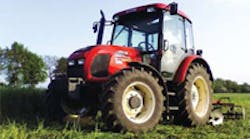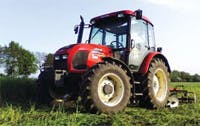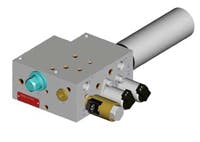Edited by Alan L. Hitchcox
Screw-in and slip-in cartridge valves have become commonplace in hydraulics — especially in mobile equipment. No wonder. Their modular design is compact, lightweight, and much less labor intensive to install and maintain than conventional, line-mounted valves. And a complete hydraulic integrated circuit — consisting of a manifold and cartridge valves — can be far less costly than the valves, hose, tubing, and fittings needed for line-mounted valves. The integrated circuit is also far less prone to leakage.In responding to the growing popularity of cartridge valves, Argo- Hytos GmbH, Kraichtal-Menzingen, Germany, expanded its product line in 2006 to include a range of slip-in valves. Slip-in valves, intended for pressures to 50 bar (735 psi), do not have a screw-in thread. Instead, the valve is held in place by a clamping fork. Slip-in valves hold the potential to reduce costs in high-volume applications.
Argo-Hytos currently offers two slip-in valves: a 3-port, 2 position directional valve and a direct-operated, proportional pressure reducing valve.
The design of these valves allow:
- • a wider working temperature range (–30° to 90 °C),
- lower pressure losses (ΔP),
- tighter proportional pressure reducing capability, and
- a simpler actuating solenoid and a pole tube that cannot be separated.
Applications
These valves are intended for pilot- pressure control mobile hydraulic systems. Typical applications include clutches, gear shifting, and pilot valves in power stages. Among the equipment manufacturers that have begun using valves are Czech manufacturer Zetor and Agco-Fendt, of Germany.
Zetor tractors — In addition to its liberal use of screw-in cartridge valves, Zetor also uses slip-in cartridges in its Proxima line of tractors. By combining the control valves, proportional valves, and a pressure filter within a valve manifold, Zetor was able to reduce component cost and simplify assembly — even within a smaller space.
The slip-in valves in Zetor’s tractors shift the clutches in the transmission. The clutches shift the transmission’s forward and reverse drives while controlling the direction of rotation and braking a power-take-off. The transmission also contains a hydraulically steered reduction gear unit. Controlling the clutch for the reduction gear unit is achieved using slip-in proportional pressure-reducing valves.
The valve manifold is installed on the tractor’s rear axle gearbox. Pressurized hydraulic fluid is fed to the manifold through a flange surface on the gearbox, with the implements connected by hose assemblies. An Argo- Hytos D 064 pressure filter is built into the manifold for a clean, compact design and easy accessibility for maintenance.
The slip-in valves present a real cost-effective alternative to the screw-in cartridge valves in low-pressure applications. The slip-in valves reduce manifold machining costs because they do not need threads. The slip-in valves may also require less space.
Agco-Fendt tractors — Slip-in valves in Agco-Fendt tractors are flange mounted onto a cast manifold on the vehicle’s rear axle gearbox. Pump, tank, and implement connections are made via precast channels. The hydraulic manifold controls the following functions:
- a power takeoff clutch via a proportional pressure reducing valve,
- three-speed shifting of the power takeoff,
- five implement functions via 3-port, 2-positioin directional valves,
- engaging and disengaging 4-wheel drive, and
- engaging and disengaging differential lock.
The valves are actuated electrically through the tractor’s control electronics. Argo-Hytos products and services are available in the U. S. from Argo-Hytos Inc., Bowling Green, Ohio. For more information, call (419) 353-6070, or visit www.argo-hytos.com.



